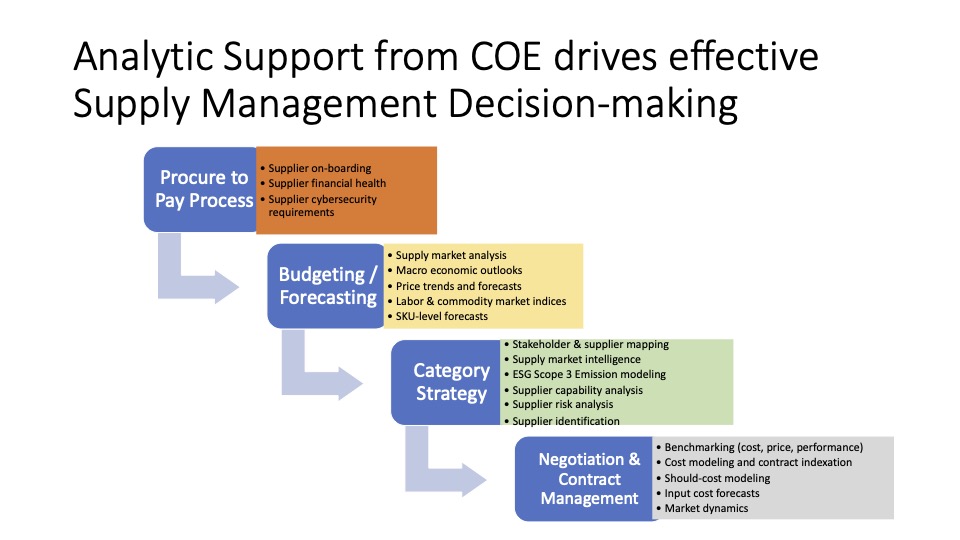IBM Case Study Webinar: How AI Can Revolutionize Your Supply Chain NOW

Robert Handfield, Bank of America Distinguished Professor of Supply Chain Management at the NC State Poole College of Management, was among participants in a recent IBM webinar on the impact of artificial intelligence on supply chain decision-making. He summarized the discussion in the following post on his blog, Supply Chain View from the Field, published November 15, 2017.
I had the privilege of being on a webinar today with Jeannette Barlow from IBM and Simon Ellis from IDC. The focus was on the impact of artificial intelligence (AI) on supply chain decision-making, speaking about a recent case study on IBM’s application of Watson to their own supply chain.
IBM, like many large enterprises, is always under pressure to drive shareholder returns. And like many other companies, their leaders recognized that they needed to respond to the business drivers that created revenue growth, new market penetration, and on-going cost savings. The supply chain is certainly a source of improvement for driving these elements, and like other companies, IBM’s supply chain contained too many suppliers, black holes where material disappears under the radar, inbound/outbound disconnects, and other discontinuities in their end-to-end business processes. The leadership team also recognized that the only way they could be more agile was to focus on changing the end-to-end supply chain in a way that was entirely novel. There was a real desire to have information more quickly, in real time; to be able to access information about what was happening more quickly; to respond to problems; but, also to drive quicker business insights and exploit opportunities to add value for clients. Data governance was a challenge, as there often existed multiple versions of data and no single source of truth. And all the while, there were also escalating requirements for compliance, both from a legal standpoint (and) also in terms of sustainable operations, and to exploit the power of Watson to make this happen. In particular, the leadership team recognized that there were four areas that required improvement right away.
- Risk Identification. One of their executives noted that “We didn’t identify risks and issues early enough. We were like a raft in the river, with no ability to see around the corner, not knowing what rapids lay ahead, and floating along wherever the current took us.” Supply chain problems were always recognized after the fact, and were not being predicted ahead of time. In retrospect, the signs of a disruption were evident, but nobody knew how or where to look for them ahead of time. On the other hand, maybe somebody, somewhere in the supply chain, may have some inkling about the problem, but not the person responsible for calling the shots or making the decision. And so nobody was able to adjust the pace, and the entire organization went along like a raft in the river, responding to every current and eddy that moved it along at whatever pace the river determined. Nobody was in control of the raft, and it was a constant reaction to events.
- Lacking the Right Information. Some risk management systems provide alerts. But alerts are just that – like a light that shows up on your automobile dash panel, telling you that something is wrong. But like a dash panel alert, it doesn’t tell you what the nature of the problem is, the technical details on how the problem can be solved, or the exact location of the issue. To create a truly transparent solution to risk management, it is critical to identify the element metadata associated with the problem, and the touch points in the network that need to come together to address the issue. The user experience should be characterized by immediate notification to and event and the right information to make a decision.
- Teams Make Decisions, Not Individuals. The third critical need identified was the recognition by IBM that decisions are made by cross-functional, cross-enterprise, and multiple tiers of people, not by individuals in a void. In order to respond to an issue or decide on resource allocation in the face of uncertainty, multiple points of view almost always yield a better decision. But the speed of decision-making is also important. So the challenge became, how can IBM build a solution room to enable a virtual come-together meeting, as opposed to the usual chain of emails and texts that often cause more confusion than anything else. IBM recognized that “we are good at working on big problems in a war-room task force environment, but often struggle with the small day-to-day issues that arise.” The ability to create a smaller “resolution room” that could be rapidly deployed in an ad hoc manner, to address supply chain issues in an agile manner, was another major business driver that led to the need for real-time transparent supply chains.
- Learning from the Past. The final business driver that led IBM to pursue this strategy was the fact that the same issues often occurred – yet were treated as new every time. The team recognized that while they were creating “gold nuggets” each time in response to issue resolution situations, there was no way to capture the key “lessons learned” to create organizational learning from these instances. The team recognized that “if we could digitize the way we solve problems – in terms of who was invited, how long did it take, the metadata and dynamics of the team, and the content that ended up solving the problem, we could respond more quickly to similar situations that came up.” This became part of the cognitive approach that required creating a system that was enabled with ways to learn from situations, and that learned from these instances, capturing these essential elements and creating a closed loop on how to better manage the end-to-end supply chain.
Individuals dealing with an issue must be able to understand the processes of the end-to-end supply chain, and be able to come together with others in a fast action plan. This requires individuals who are willing to be key informants and who are willing to transcend typical functional barriers between sales, operations and procurement, to drive the right solutions.
In this webinar, Simon also discussed his views on how intelligence, analytics, MBL and cognitive computing are moving together along a continuum. Jeannette spoke about the “supply chain playbooks” that IBM is designing around their Watson capability. I learned a lot from these individuals and urge anyone who is interested to take the time to listen to the webinar and to read this IBM white paper on the topic. [Note: registration will be required to listen to the webinar.]
This post was originally published in Poole College of Management News.


